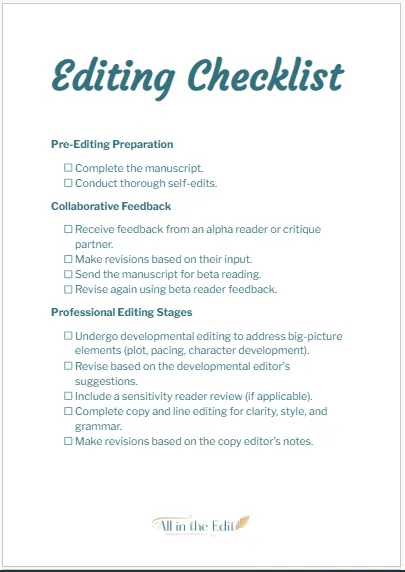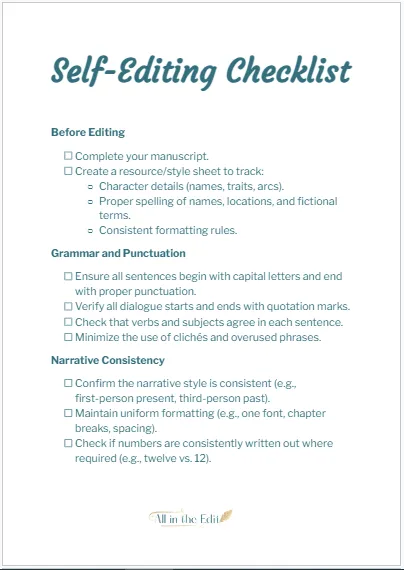
How to Set Effective Writing Goals (and Stick to Them!) | All in the Edit
Introduction
Writing is a craft that thrives on discipline, consistency, and passion. Whether you’re working on a novel, a blog, or academic research, setting clear writing goals can help you stay on track and achieve success. However, many writers struggle with maintaining motivation or following through on their goals.
So how can you create effective writing goals—and more importantly, how can you stick to them? Here’s a step-by-step guide to help you set realistic targets and develop strategies to ensure you meet them.
1. Start with Your Purpose: Why Are You Writing?
Before you set a single goal, take a moment to define why you’re writing. Understanding your purpose will provide you with the motivation to keep going when challenges arise.
Are you writing a novel you’ve always dreamed of publishing?
Do you want to grow your blog or business through consistent content creation?
Are you refining your writing skills for a professional or academic pursuit?
Your goals should align with your bigger vision. When you have a strong why, it’s easier to stay committed.
2. Use the SMART Goal Framework

A vague goal like “write more” or “finish my book” is difficult to measure and easy to abandon. Instead, apply the SMART goal framework:
Specific – Define exactly what you want to achieve (e.g., “Write a 60,000-word novel”).
Measurable – Track your progress (e.g., “Write 1,000 words per week”).
Achievable – Be realistic about what you can commit to (e.g., “Write for 30 minutes daily”).
Relevant – Make sure your goals align with your broader writing ambitions.
Time-bound – Set deadlines to maintain momentum (e.g., “Complete the first draft in six months”).
By applying this framework, you transform abstract ideas into actionable steps.
3. Break Down Big Goals into Manageable Milestones
Large goals can feel overwhelming, which often leads to procrastination. The solution? Break them into smaller, bite-sized tasks.
For example, if your goal is to write a novel:
Start by outlining your story.
Set a target for how many words you’ll write each week.
Plan checkpoints to revise and refine sections along the way.
By tackling smaller steps, you’ll maintain momentum and avoid feeling stuck.
4. Establish a Writing Routine

Consistency is one of the biggest factors in achieving writing goals. Here’s how to build a routine that works:
a) Find Your Most Productive Writing Time
Some people write best early in the morning, while others are night owls. Experiment to find when you’re most creative and alert.
b) Set a Schedule (and Stick to It!)
Schedule writing sessions as you would any other important commitment. Even if you only have 30 minutes a day, consistency is more important than intensity.
c) Create a Dedicated Writing Space
Having a quiet, clutter-free environment can enhance focus and productivity. Make your space inviting and free from distractions.
5. Minimize Distractions and Stay Focused
Distractions can quickly derail even the best writing intentions. To stay focused:
Turn off notifications on your phone and computer.
Use productivity apps like Forest, Freedom, or Cold Turkey to block distracting websites.
Set a timer for focused writing sprints (e.g., 25-minute Pomodoro sessions).
Let family or roommates know when you need uninterrupted writing time.
Protecting your writing time will make it easier to stay consistent.
6. Track Your Progress and Celebrate Wins

Monitoring your progress can boost motivation and help you adjust as needed. Some ways to track progress include:
Keeping a writing journal to log word counts and achievements.
Using apps like Scrivener, Notion, or Trello to organize projects.
Setting small rewards (e.g., a coffee treat after hitting a milestone).
Celebrating small victories will keep you motivated for the long run.
7. Find Accountability and Support
Writing can be a solitary endeavor, but having accountability can make a huge difference. Here’s how to stay on track:
a) Join a Writing Group
Connecting with other writers can provide encouragement, feedback, and accountability. Consider joining a local or online writing community.
b) Work with an Accountability Partner
Find someone to check in with regularly about your progress. Knowing that someone is expecting an update can keep you motivated.
c) Announce Your Goals Publicly
Sharing your writing goals on social media or with friends can create external motivation to follow through.
8. Embrace Flexibility and Overcome Setbacks

Life happens. There will be days when you don’t meet your word count or when writer’s block sets in. The key is to be kind to yourself and stay adaptable.
If you miss a writing session, don’t dwell on it—just start fresh the next day.
If a goal feels too ambitious, adjust it rather than abandon it altogether.
Recognize that progress is more important than perfection.
Writing is a journey, not a race—what matters most is staying committed over time.
Final Thoughts: Make Writing Goals Work for You
Setting writing goals is the first step toward achieving your creative dreams. But more importantly, developing habits and strategies to stick to them will help turn your aspirations into reality.
At All in the Edit, we understand the challenges writers face, and we’re here to support you every step of the way. Whether you need professional editing, publishing guidance, or accountability in your writing journey, we’re here to help.
What writing goals are you setting this year? Share them in the comments below!


